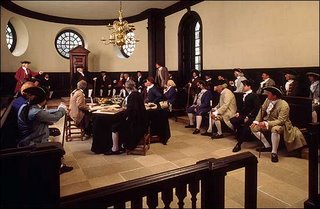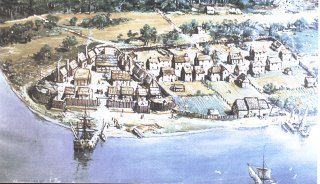Sopping Wet in the Historic Triangle
They say that "Virginia is for Lovers", and that may well be true. But it is also a place rich in American history. From the first British settlement at Jamestown up and through the Civil War, there are numerous opportunities to visit historic homes, battlefields, plantations, and interesting sites. The state even has a "Department of Historic Resources", which shows the importance they place on preservation and interpretation. It is said that there are over 2000 interpretive signs along Virginia's highways, and we've stopped to read a good number of them.
As we wheeled into the Colonial Williamsburg visitors center, we once again had good fortune smile upon us. Even though the town was supposed to be full for the christening of the new aircraft carrier named in honor of George Bush I, they had a few rooms left at the inn. We started to burn a hole in the credit card, and it didn't let up until the rain did, which was 3 days hence.

Colonial Williamsburg was conceived in the 1920s by a group of citizens that wanted to preserve and portray life in Virginia around the time of the American Revolution. Major funding for the effort came from one of the Rockefeller's, which if you're trying to do historic preservation is a darn good benefactor to have on your side. Over the years the town has been recreated, and there are numerous displays to visit, re-enactments to witness, and taverns to dine at. It was a bit over the top for us, but an interesting visit nonetheless. And considering our options, it was a darn good place to be. We had a fine time learning about colonial life, talking to the different craftspeople and "townfolk", and some excellent meals. Another big "plus" for us was that there was a shuttle bus service to all the attractions, meaning we could get to all the local sights without needing to ride through the rain.
With the rains finally letting up, we decided to try our luck and head out back on the trail. The newspapers reported that over 8 inches had fallen in two days, with more rain reported in the surrounding areas. It would take us another day to appreciate what that meant. The route our of Williamsburg took us directly passed Jamestown, the first permanent British colonial in North America. As a refresher, in June of 1606, King James I granted a charter to a group of London entrepreneurs, the Virginia Company, to establish a satellite English settlement in the Chesapeake region of North America. By December, 108 settlers sailed from London instructed to settle Virginia, find gold and a water route to the Orient. Some traditional scholars of early Jamestown history believe that those pioneers could not have been more ill-suited for the task.
Because Captain John Smith identified about half of the group as "gentlemen", it was logical, indeed, for historians to assume that these gentry knew nothing of or thought it beneath their station to tame a wilderness. Recent historical and archaeological research at the site of Jamestown suggest that at least some of the gentlemen and certainly many of the artisans, craftsmen, and laborers that accompanied them all made every effort to make the colony succeed. On May 14, 1607, the Virginia Company explorers landed on Jamestown Island, to establish the Virginia English colony on the banks of the James River 60 miles from the mouth of the Chesapeake Bay. By one account, they landed there because the deep water channel let
 their ships ride close to shore; close enough, to moor them to the trees. Recent discovery of the exact location of the first settlement and its fort indicates that the actual settlement site was in a more secure place, away from the channel, where Spanish ships, could not fire point blank into the Fort. Almost immediately after landing, the colonists were under attack from what amounted to the on-again off-again enemy, the Algonquian natives. As a result, in a little over a months' time, the newcomers managed to "beare and plant palisadoes" enough to build a wooden fort. Three contemporary accounts and a sketch of the fort agree that its wooden palisaded walls formed a triangle around a storehouse, church, and a number of houses. While disease, famine and continuing attacks of neighboring Algonquians took a tremendous toll on the population, there were times when the Powhatan Indian trade revived the colony with food for copper and iron implements. It appears that eventual structured leadership of Captain John Smith kept the colony from dissolving. The "starving time" winter followed Smith's departure in 1609 during which only 60 of the original 214 settlers at Jamestown survived. That June, the survivors decided to bury cannon and armor and abandon the town. It was only the arrival of the new governor, Lord De La Ware, and his supply ships that brought the colonists back to the fort and the colony back on its feet. Although the suffering did not totally end at Jamestown for decades, some years of peace and prosperity followed the wedding of Pocahontas, the favored daughter of the Algonquian chief Powhatan, to tobacco entrepreneur John Rolfe. The first representative assembly in the New World convened in the Jamestown church on July 30, 1619. The General Assembly met in response to orders from the Virginia Company "to establish one equal and uniform government over all Virginia" which would provide "just laws for the happy guiding and governing of the people there inhabiting."
their ships ride close to shore; close enough, to moor them to the trees. Recent discovery of the exact location of the first settlement and its fort indicates that the actual settlement site was in a more secure place, away from the channel, where Spanish ships, could not fire point blank into the Fort. Almost immediately after landing, the colonists were under attack from what amounted to the on-again off-again enemy, the Algonquian natives. As a result, in a little over a months' time, the newcomers managed to "beare and plant palisadoes" enough to build a wooden fort. Three contemporary accounts and a sketch of the fort agree that its wooden palisaded walls formed a triangle around a storehouse, church, and a number of houses. While disease, famine and continuing attacks of neighboring Algonquians took a tremendous toll on the population, there were times when the Powhatan Indian trade revived the colony with food for copper and iron implements. It appears that eventual structured leadership of Captain John Smith kept the colony from dissolving. The "starving time" winter followed Smith's departure in 1609 during which only 60 of the original 214 settlers at Jamestown survived. That June, the survivors decided to bury cannon and armor and abandon the town. It was only the arrival of the new governor, Lord De La Ware, and his supply ships that brought the colonists back to the fort and the colony back on its feet. Although the suffering did not totally end at Jamestown for decades, some years of peace and prosperity followed the wedding of Pocahontas, the favored daughter of the Algonquian chief Powhatan, to tobacco entrepreneur John Rolfe. The first representative assembly in the New World convened in the Jamestown church on July 30, 1619. The General Assembly met in response to orders from the Virginia Company "to establish one equal and uniform government over all Virginia" which would provide "just laws for the happy guiding and governing of the people there inhabiting."The other crucial event that would play a role in the development of America was the arrival of Africans to Jamestown. A Dutch slave trader excanged his cargo of Africans for food in 1619. The Africans became indentured servants, similar in legal position to many poor Englishmen who traded several years labor in exchange for passage to America. The popular conception of a race-based slave system did not fully develop until the 1680's. The Algonquians eventually became disenchanted and, in 1622, attacked the out plantations killing over 300 of the settlers. Even though a last minute warning spared Jamestown, the attack on the colony and mismanagement of the Virginia Company at home convinced the King that he should revoke the Virginia Company Charter. Virginia became a crown colony in 1624. The fort seems to have existed into the middle of the 1620s, but as Jamestown grew into a "New Town" to the east, written reference to the original fort disappear. Jamestown remained the capital of Virginia until its major statehouse, located on the western end of the APVA property, burned in 1698. The capital was moved to Williamsburg that year and Jamestown began to slowly disappear above ground.
Taking our leave of Jamestown, we crossed the James River on the free ferry and rode on towards our nights stay at Chippokes State Park. It was obvious that the wind and rain had down considerable damage on the south side of the river. Road crews were everywhere cleaning up debris from the the storm. In fact, they told us that they had just opened the roads a few hours early, so our timing was quite fortuitious. We camped that night under a waning full moon at Chippokes. It's a beautiful, well maintained facility. In fact, we've found that state parks provide the best camping value...spacious campgrounds, hot showers, clean restrooms, and generally for $20 or less.
Chippokes Plantation State Park is one of the oldest working farms in the United States. Chippokes is a living historical exhibit located in a rural agricultural area along the James River in Surry County. In addition, the park has a wide variety of traditional park offerings, including a swimming complex, visitor center, picnic facilities, and hiking and biking trails. The plantation has kept its original boundaries since the 1600s and has a variety of cultivated gardens and native woodland. The formal gardens surrounding the Chippokes Mansion are accented by azaleas, crepe myrtle, boxwood and seasonal flowers. The plantation grounds are also home to the Chippokes Farm and Forestry Museum. The next morning we awoke to warm sunshine and visited the plantation and museum. As we continued our journey south, we passed peanuts growing in the field for the first time. We were back on the road and feeling full of ourselves, having weathered a near record storm in relative comfort. We had no idea of the trials that awaited us around the bend...

0 Comments:
Post a Comment
<< Home